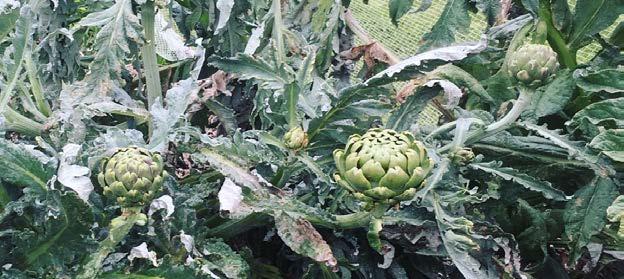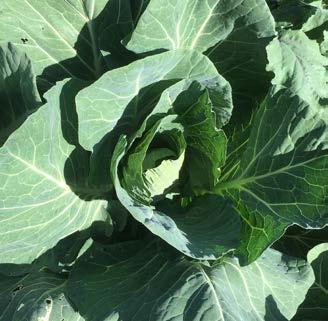
8 minute read
Escape to Otway Fields
by Ami Hillege
There’s nothing like a pandemic to create a new focus on becoming just a little more self-sufficient. Most seasons I amble through the tasks of planting, harvesting and cleaning up garden beds, before starting the process all over again. I’ve always loved placing food on the table that I’ve grown, but I’ve been rather casual about it. Now I realise that I have a responsibility to myself, my family and my garden to nurture this patch of dirt and be more proactive in growing our own produce. Sure, there’s going to be excess produce. And isn’t that a wonderful problem to have?! Frans and I have always followed this mantra: “Grow it yourself. Barter and share with neighbours and family. Buy local. Keep your food miles low. Eat seasonally. And look after the bees!” Besides being able to enjoy our own produce and share the excess, the simple act of growing our own food gives me great satisfaction. There’s so much more to vegetable gardening than sticking a few seeds into some dirt. Each season comes with the excitement of planning the planting of the next season’s bounty. I love to pour over seed catalogues, sort my seed packets, make lists and glean as much information and inspiration I can find before getting started. My planning and pondering at the beginning of autumn made me consider our current garden layout. To achieve maximum results for the effort I’m willing to commit to growing food, I realised I needed to change the structure of one garden area. I coerced some strong fellas, (husband, son in law and a mate), to rejig the area that held three very long, ugly, raised beds, and soon I was doodling on graph paper and plotting out the planting schedule for a new potager kitchen garden. Gone were the metal sheets, and in place were a dozen neat garden beds, one width of timber high. I have found that I have much more success with vegetables when they’re grown close to the ground. The previous metal raised beds tended to dry out quickly, so I was keen to try a new approach.
Advertisement
Vegetable garden with a view across the Otways
Men at work. Constructing the new potager garden

I’m the sort of gardener who likes straight lines, yet I know that a random vegetable patch is just as productive and probably more resistant to the critters who love to feast on everything that has been planted for food. So, I’ve decided to plant my two separate kitchen gardens in two completely different styles. My original garden is covered by a large netted area (it needs to be redone shortly, and that’s another big job on the never ending list!) and this will be the untamed, ‘plant it where there’s a space’ food garden. Here I will allow fennel to go to seed, providing the bees and pollinators a feast of pollen, lettuces will be allowed to self-seed and kale will be encouraged to flower. I’m not too fussy about keeping roots in their own bed, or having a dedicated leaf bed. Instead, I’ll use more of a permaculture approach, practice companion planting and allow plants to follow their full growth cycle. This will allow me to save and share seeds from this prolific kitchen garden. The new potager garden is far more formal and I love it. (those straight lines!) Twelve neat beds are planted with crop rotation in mind. The pathways are wide enough to move between the beds freely with a wheelbarrow or garden trolley, and a central aisle is wide enough to get the tractor in to dump compost or mulch, saving a lot of wheelbarrow work. The rule of thumb I like to use with planting is as follows: First legumes; beans and peas, followed by roots. These are obviously carrots, beets, turnips, onions and garlic. After roots, I will plant fruit. Think about tomatoes, cucumbers, squash, peppers and eggplants. Finally, after the fruit bed is done fruiting, the leaves get their turn. Now the herbs, spinach, lettuce, brassicas and other leafy greens get planted in that tomato bed. The beauty of having twelve beds, is that I can dedicate four beds to each vegetable category. I don’t have to wait till the end of summer to plant greens in the tomatoes bed. I can start them all at once and follow the rotation pattern. I’m writing this piece as we enter the last month of Spring. We’ve been feasting on produce from the garden for months now. Dinner is determined by what gets picked each day. The delight of picking our first telephone peas, broad beans and artichokes is a treat we look forward to each year. Our favourite spring recipe is one inspired by the book “Honey from a weed” by Patience Gray. This book is wonderful. It’s part memoir, part recipes. No fancy pictures, and the recipes are mostly suggestions. It’s a book you can dip in and out of and pick up little growing and cooking tips here and there. If you love collecting good recipe books, then this is one you’ll use and love.

Garden beds settling into the business of growing
CARCIOFI CON RISO - Artichokes with rice

Peel back the outer leaves of 6 artichokes, leave an inch or so of the stem, quarter them and remove the choke (the fuzzy bit inside).
Fry in olive oil in a shallow pan with 2 peeled cloves of garlic.
When slightly brown, add a cupful of arborio rice, cook for 3 minutes, stirring. Then add 3 cups of hot chicken stock, a little at a time. You’re basically making a risotto.
Add a dozen or so rinsed capers. I love to add freshly podded broad beans and peas too if they’re ready. Cook till the liquid is absorbed.
Add chopped parsley or coriander. Turn out into an earthenware dish and cover with several layers of cloth. Wait 10 minutes and enjoy with hard boiled eggs for a lovely spring dish.


Broad beans emerging in the wooden frame
One of the best pieces of advice I’ve implemented this past season is to build a structure to contain the broad beans. I’ve been so impressed at the success of this simple but effective frame. I’ve not lost any plants to the strong damaging winds that we have experienced over the past few weeks. This tip was one I learned from Mickey Robinson at Glenmore House. Mickey has a very informative podcast that takes you through an entire year of planting and growing. For the first time this season, I’ve also managed to grow some magnificent cabbages and a swathe of broccoli and cauliflower. There is no reason why they should be so good this year other than this one thing. When I planted the seedlings way back in April, I put a wire frame over the seedlings, high enough to give them some room to grow. Then I covered the frame with mosquito netting. The seedlings grew beautifully, and no cabbage moth came near them. Once the plants hit the top of the frame, I removed the protection and by then the moths had all disappeared. Maybe I got lucky, but this is one practice I will use again. There’s one consideration I need to make next season, and that is to think ‘less is more’. Brassicas take up an awful lot of real estate in a vegetable bed, and they can get overcrowded if planted too close together. A punnet of six cabbages is going to keep us well fed for months! We’re looking forward to stuffed cabbage rolls, braised cabbage with bacon, and of course a good batch of sauerkraut.
As summer advances, I’m anticipating the arrival of the first ripe tomatoes, the berries and the stone fruit. Preserving our harvest as we cross over the seasons will more important as we adjust to our new Covid-normal. One thing 2020 had taught us is to make the most of what we have and to appreciate it.

Garden beds settling into the business of growing

Monster cabbages
These are a few of my favourite things:
1. Audible books. Borrow Box is an app that allows you to download books from your library. You will never catch me in the garden without someone reading to me. 2. My Spotify playlist. Ami’s Music. A little bit laid back, not too noisy! 3. My Pantry by Alice Waters. Alice is my food hero!
Keep it simple. Keep it fresh. This recipe book is a guide to making and curating pantry staples. 4. Any recipe book by Yotham Ottolenghi. Simple is one I love especially. I want to make everything in it! (I have them all except the latest, Flavour. Santa are you reading this?) 5. Lambley gardens and nursery located at Ascot,
Victoria. A visual treat.
6. Great Dixter for pure garden inspiration.
International travel may not be on the cards for a while, but we can still virtually enjoy a stunning country garden. 7. Our Permaculture Life by Morag Gamble. There is so much to learn from this amazing permaculture educator. Watch her YouTube videos for ideas of growing and eating your harvest. She got me eating sorrel! 8. Green Harvest for seeds. I’ve been using them for years and their strike rate is good. 9. Ravelry for thousands of yarn projects! My current favourite knit designers are Stephen West, Kate
Davies and Marie Wallen. As much as I love my garden, I can’t wait to pick up my knitting needles each evening. 10. Tarndie for locally grown yarn. What can be better than knowing where your wool was grown?! Check out the new wool shop. 11. Yellowstone on Stan. What can I say? Kevin
Costner is still a hunk!
Follow Ami on Website: https://www.otwayfields.com











